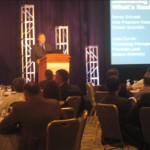Dec13
Mayo Clinic’s Collaborative Innovation Process
Point: Collaboration between doctors, patients, designers and lab technicians brings healthcare delivery breakthroughs.
Story: The inspiring origins of the Mayo Clinic illustrate the timelessness of collaborative innovation. Back in the 1880s, two brothers, Will and Charles Mayo, founded the clinic with their father, Dr. William Worrall Mayo, and introduced the concept of a group practice. The Mayos sought medical breakthroughs by bringing together doctors, laboratory experts, and business people. As the younger Will Mayo said, “In order that the sick may have the benefit of advancing knowledge, a union of forces is necessary.”
Today, we have the fruits of many medical breakthroughs but need better ways to deliver the breakthroughs in efficient and effective ways. Many chronic diseases, like diabetes, can be treated but depend on more than just a one-shot procedure in a doctor’s office or hospital. For these conditions, healthcare delivery requires education and engagement between doctors and patients. The quest for new breakthroughs in healthcare delivery calls for a new round of collaborative innovation, embodied by the Mayo Clinic’s SPARC unit.
The Mayo Clinic uses SPARC to develop new services for patients. SPARC stands for See, Plan, Act, Refine, Communicate. Mayo believes in a fast prototyping approach: a crossfunctional team of doctors, industrial designers, patient education experts, facilities people and financial analysts work together to create new ideas and test them in the “Hub.” The collaboration includes some of the usual healthcare and research leaders, like Blue Cross Blue Shield of Minnesota, University of Minnesota, MIT, Yale, and GE Healthcare. But it also attracts collaborators from industry, such as IDEO, Best Buy, Steelcase, Microsoft, and Cisco.
The Hub creates reconfigurable prototypes of patient check-in counters and examination rooms. The team that develops a new service can observe the prototypes in action through glass and via video. “We take research out of the laboratory and translate it in a very quick and meaningful way right to the patient’s bedside,” said Dr. Glen Forbes, CEO of Mayo’s Rochester, MN campus. “That takes a lot of collaboration, because you’re crossing cultures and you’re often times crossing a lot of internal organization structures and silos.”
Most crucially, the Mayo Clinic engages patients to accelerate innovation. “Our patients have a long history of participating in our research and education endeavors,” says Barbara Spurrier, Administrative Director, Mayo Clinic Center for Innovation. The Mayo uses ethnographic techniques to analyze the quality of doctor-patient interactions, survey patients for their impressions, and talk to patient’s families. Human-centered design thinking ensures that the innovations aren’t just technically correct, they deliver higher quality of life for patients.
Action:
- Find a gap between technology and society, such as the gap between the capabilities of a technology (e.g., a medical treatment) and the delivery of that technology (e.g., a patient’s compliance)
- Recruit collaborators from both the technology side and the people side to bridge the gap
- Create tangible and testable examples of innovations through visualization, modeling and rapid prototyping
- Use both hard science and soft science methods to gain both objective and subjective feedback for further innovations
For more information:
Mayo Clinic Center for Innovation Partnerships
Leonard Berry and Kent Seltman, Management Lessons from Mayo Clinic: Inside One of the World’s Most Admired Service Organizations, 2008
Evan Rosen, The Culture of Collaboration: Maximizing the Time, Talent and Tools to Create Value in the Global Economy, 2009
Comments Off on Mayo Clinic’s Collaborative Innovation ProcessCase study, CEO, How-to, Innovation, open innovation, Strategy










